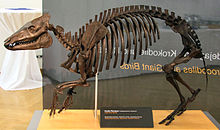Propalaeotherium
| Propalaeotherium Temporal range: Early-Middle Eocene
| |
|---|---|

| |
| Restored P. hassiacum skeleton | |
| Scientific classification | |
| Domain: | Eukaryota |
| Kingdom: | Animalia |
| Phylum: | Chordata |
| Class: | Mammalia |
| Order: | Perissodactyla |
| Family: | †Palaeotheriidae |
| Genus: | †Propalaeotherium Gervais, 1849 |
| Species | |
| |
Propalaeotherium was an early genus of equid endemic to Europe and Asia during the Middle Eocene.
Taxonomy

Propalaeotherium was named by Paul Gervais: its name means "before Palaeotherium". It was considered a member of Palaeotheriidae by Hooker (1986).[1] A 2004 study found it to be an equid instead.[2]
The species P. parvulum and P. messelensis have been assigned to the equid genus Eurohippus.[3]
Description

Propalaeotheres were small animals, ranging from 30–60 cm at the shoulder (2.9 to 5.9 hands) weighing just 10 kg (22 lb).[4] They looked rather like very small tapirs. They had no hooves, having instead several small nail-like hooflets. They were herbivorous, and the amazingly well-preserved Messel fossils show that they ate berries, and leaf matter picked up from the forest floor.[5]
See also
References
- ^ J. J. Hooker. 1986. Mammals from the Bartonian (middle/late Eocene) of the Hampshire Basin, southern England. Bulletin of the British Museum (Natural History) 39(4):191-478
- ^ Franzen, J. L. (2004). "First fossil primates from Eckfeld Maar, Middle Eocene (Eifel, Germany)". Eclogae Geologicae Helvetiae. 97 (2): 213–220. doi:10.1007/s00015-004-1115-8.
- ^ Franzen, J. L. (2006). "Eurohippus n.g., a new genus of horses from the Middle to Late Eocene of Europe". Senckenbergiana lethaea. 86: 97–102. doi:10.1007/BF03043638.
- ^ S. Legendre. 1988. Les communautes de mammiferes du Paleogene (Eocene superieur et Oligocene) d'Europe occidentale: structure, milieux et evolution. Ph.D. thesis, Universite des Sciences et Techniques du Languedoc, Montpellier, France. 2 volumes. 1-265.
- ^ Wilde, V.; Hellmund, M. (2010). "First record of gut contents from a middle Eocene equid from the Geiseltal near Halle (Saale), Sachsen-Anhalt, Central Germany". Palaeobiodiversity and Palaeoenvironments. 90 (2): 153. doi:10.1007/s12549-010-0028-y.
